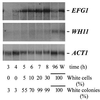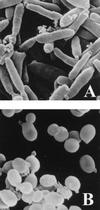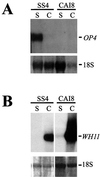Control of white-opaque phenotypic switching in Candida albicans by the Efg1p morphogenetic regulator
- PMID: 10456912
- PMCID: PMC96790
- DOI: 10.1128/IAI.67.9.4655-4660.1999
Control of white-opaque phenotypic switching in Candida albicans by the Efg1p morphogenetic regulator
Abstract
Phenotypic switching in Candida albicans spontaneously generates different cellular morphologies and is manifested in strain WO-1 by the reversible switching between the white and opaque phenotypes. We present evidence that phenotypic switching is regulated by the Efg1 protein, which is known as an essential element of hyphal development (dimorphism). Firstly, EFG1 is expressed specifically in cells of the white but not the opaque phenotype. During mass conversion from the opaque to the white phenotype, the EFG1 transcript level correlates with competence of switching of opaque cells to the white form. Secondly, overexpression of EFG1 by a PCK1p-EFG1 fusion forces opaque-phase cells to switch to the white form with a high level of efficiency. Thirdly, low-level expression of EFG1 in strain CAI-8 generates a cellular phenotype similar to that of opaque cells in that cells bud as short rods, which cannot be induced to form hyphae in standard conditions; such cells (unlike authentic opaque cells) lack typical surface "pimples." Importantly, the opaque-specific OP4 transcript is induced in the opaque-like cells generated by strain CAI8 as a response to low-level expression of EFG1. The results suggest that high EFG1 expression levels induce and maintain the white cell form while low EFG1 expression levels induce and maintain the opaque cell form. It is proposed that changes in EFG1 expression determine or contribute to phenotypic switching events in C. albicans.
Figures






Similar articles
-
Deletion of EFG1 promotes Candida albicans opaque formation responding to pH via Rim101.Acta Biochim Biophys Sin (Shanghai). 2010 Oct;42(10):735-44. doi: 10.1093/abbs/gmq076. Acta Biochim Biophys Sin (Shanghai). 2010. PMID: 20870932
-
EFG1 null mutants of Candida albicans switch but cannot express the complete phenotype of white-phase budding cells.J Bacteriol. 2000 Mar;182(6):1580-91. doi: 10.1128/JB.182.6.1580-1591.2000. J Bacteriol. 2000. PMID: 10692363 Free PMC article.
-
Candida albicans Double Mutants Lacking both EFG1 and WOR1 Can Still Switch to Opaque.mSphere. 2020 Sep 23;5(5):e00918-20. doi: 10.1128/mSphere.00918-20. mSphere. 2020. PMID: 32968010 Free PMC article.
-
EFG1, Everyone's Favorite Gene in Candida albicans: A Comprehensive Literature Review.Front Cell Infect Microbiol. 2022 Mar 22;12:855229. doi: 10.3389/fcimb.2022.855229. eCollection 2022. Front Cell Infect Microbiol. 2022. PMID: 35392604 Free PMC article. Review.
-
White-opaque switching in Candida albicans: cell biology, regulation, and function.Microbiol Mol Biol Rev. 2024 Jun 27;88(2):e0004322. doi: 10.1128/mmbr.00043-22. Epub 2024 Mar 28. Microbiol Mol Biol Rev. 2024. PMID: 38546228 Free PMC article. Review.
Cited by
-
Structure and position-specific interactions of prion-like domains in transcription factor Efg1 phase separation.bioRxiv [Preprint]. 2023 Nov 9:2023.11.09.566450. doi: 10.1101/2023.11.09.566450. bioRxiv. 2023. Update in: Biophys J. 2024 Jun 4;123(11):1481-1493. doi: 10.1016/j.bpj.2024.01.030. PMID: 37986834 Free PMC article. Updated. Preprint.
-
Candida albicans white and opaque cells undergo distinct programs of filamentous growth.PLoS Pathog. 2013 Mar;9(3):e1003210. doi: 10.1371/journal.ppat.1003210. Epub 2013 Mar 7. PLoS Pathog. 2013. PMID: 23505370 Free PMC article.
-
Investigating Common Pathogenic Mechanisms between Homo sapiens and Different Strains of Candida albicans for Drug Design: Systems Biology Approach via Two-Sided NGS Data Identification.Toxins (Basel). 2019 Feb 15;11(2):119. doi: 10.3390/toxins11020119. Toxins (Basel). 2019. PMID: 30769958 Free PMC article.
-
Transcriptional loops meet chromatin: a dual-layer network controls white-opaque switching in Candida albicans.Mol Microbiol. 2009 Oct;74(1):1-15. doi: 10.1111/j.1365-2958.2009.06772.x. Epub 2009 Jun 23. Mol Microbiol. 2009. PMID: 19555456 Free PMC article.
-
Transcription factor Efg1 shows a haploinsufficiency phenotype in modulating the cell wall architecture and immunogenicity of Candida albicans.Eukaryot Cell. 2012 Feb;11(2):129-40. doi: 10.1128/EC.05206-11. Epub 2011 Dec 2. Eukaryot Cell. 2012. PMID: 22140230 Free PMC article.
References
-
- Cannon R D, Jenkinson H F, Shepherd M G. Cloning and expression of Candida albicans ADE2 and proteinase genes on a replicative plasmid in C. albicans and in Saccharomyces cerevisiae. Mol Gen Genet. 1992;235:453–457. - PubMed
-
- Delbrück S, Ernst J F. Morphogenesis-independent regulation of actin transcript levels in the pathogenic yeast Candida albicans. Mol Microbiol. 1993;10:859–856. - PubMed
Publication types
MeSH terms
Substances
LinkOut - more resources
Full Text Sources
Other Literature Sources
Molecular Biology Databases

